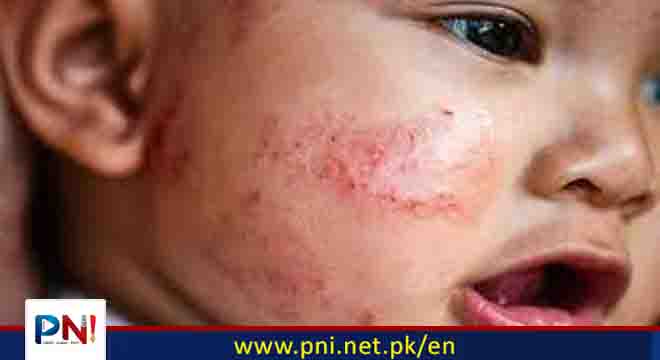ISLAMABADS, Nov 20 (Online): Atopic dermatitis, more commonly called eczema, is an unpleasant skin condition common among children.
While this may be the primary skin problem occurring, recent evidence suggests that there may be more to the story.
A study published in the Journal of the American Academy of Dermatology examined more than 900 children with and without atopic dermatitis.
The researchers reported that children who already had atopic dermatitis were more likely to have allergic contact dermatitis as well.
They said the study’s results indicate that children diagnosed with atopic dermatitis may benefit from further clinical testing to identify other skin sensitivities that may be present.
Atopic and allergic contact dermatitis
Atopic dermatitisTrusted Source is a chronic skin condition. While it is most often diagnosed during childhood, it can occur at any age.
People with atopic dermatitis often have red, itchy patches of skin that can appear in various locations. The skin condition can worsen when people scratch or pick at the skin. The precise cause of atopic dermatitis is unknown.
In contrast, allergic contact dermatitisTrusted Source happens when people have particular sensitivities and reactions when certain substances come into contact with their skin. While the cause is different, people may present with symptoms similar to atopic dermatitis. Doctors can do patch testing to figure out what is causing the allergic reaction.
In patch testing, a dermatologist will put small amounts of substances that could cause an allergic reaction on the skin and put a patch over the area. Based on the reaction, doctors can determine the cause so people can avoid that particular substance.
Sometimes, it can be challenging for doctors to distinguish between atopic and allergic contact dermatitis.
Dr. India Hill, a pediatric dermatologist at Children’s Hospital New Orleans who was not involved in the study, explained to Medical News Today:
“Atopic dermatitis is a chronic inflammatory skin disease influenced by both innate and external factors. Allergic contact dermatitis is a reproducible delayed type 4 hypersensitivity reaction to a specific allergen. Though these two conditions may occur in the same individual, they each have distinct underlying pathophysiology. The two conditions may be difficult to distinguish clinically because they share similar morphologic findings.”
Atopic dermatitis and the need for further evaluation
Researchers of the current study wanted to look more into the relationship between having atopic dermatitis and allergic contact dermatitis. They also wanted to see if children with atopic dermatitis were more likely to have reactions to specific allergens.
This study was a retrospective case-control study. Researchers included 912 children in their data collection. Of the children they included in the study, 615 of the children had atopic dermatitis and 297 did not have atopic dermatitis. These children had been referred for patch testing between 2018 and 2022.
Researchers reported that children with atopic dermatitis were more likely to have seen more providers before they underwent patch testing.
Researchers said that the children with atopic dermatitis “were more likely to have more than one positive reaction.” They also found that the children with atopic dermatitis were more likely to experience positive test results than children without atopic dermatitis.
They further reported that children with atopic dermatitis were more likely to experience an allergic response to certain substances, including bacitracin, carba mix, and cocamidopropyl betaine.
Researchers noted that children with atopic dermatitis may have increased exposure to these substances. For example, bacitracin is part of many common over-the-counter topical antibiotics and cocamidopropyl betaine is part of more gentle skin care products.
Dr. Dustin Portela, an osteopathic physician specializing in dermatology who was not involved in the study, commented on the study to Medical News Today:
“This study reveals that allergic contact dermatitis (ACD) may be under-diagnosed in our patients with AD [atopic dermatitis]. Although AD tends to make its first appearance at younger ages than ACD, these patients are more likely to develop contact allergies due to their compromised skin barrier and activated immune system. If we can more frequently identify which AD patients have concomitant ACD we can help those patients avoid their allergens and improve their disease symptoms more effectively. This should allow us to decrease those children’s exposure to topical corticosteroids.”








